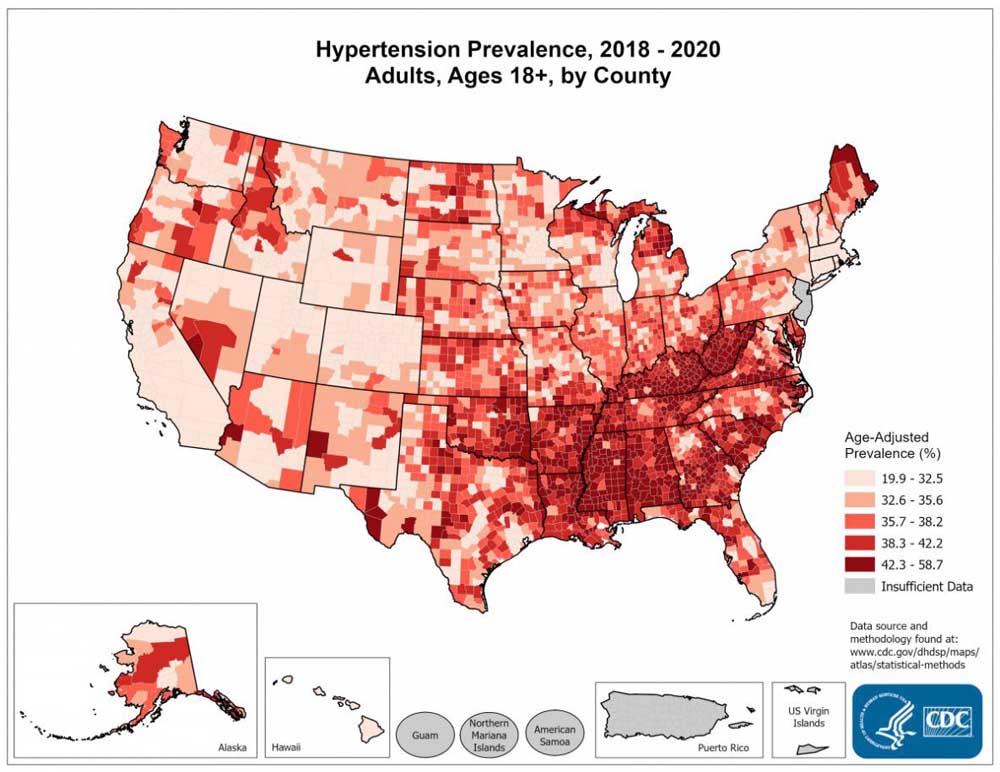Heart disease is the number one killer: what to know about heart attacks and prevention
Published 5:02 pm Wednesday, February 14, 2024

- A map shows the prevalence of high blood pressure in the United States.
Cardiovascular disease is the leading cause of death in the United States. Cardiovascular disease kills more women than all forms of cancer combined. Hypertension or high blood pressure is the number one cause of stroke. Stroke is the number five killer of Americans and heart disease is the number one killer, said Cyd King, American Heart Association Region Marketing Communications Director.
In the United States, someone has a heart attack every 40 seconds. A heart attack is something that occurs when a coronary artery becomes blocked. For example, when you have a blockage due to cholesterol. The blocked artery makes it difficult for the heart to get enough oxygen, according to King.
In 2021, the Northeast Texas mortality for heart disease was 27% higher than in Texas. If Northeast Texas were a state, it would be ranked 47th in heart disease mortality, according to The Health Status of Northeast Texas report from 2021.
What are the symptoms of heart attacks?
For both men and women heart attack symptoms include nausea, jaw, neck and back pain, and shortness of breath. Women are less likely to seek immediate care as they may not recognize they are experiencing a heart attack due to additional symptoms they experience. Women do not always experience chest pain. However they experience upper back pain, fainting, indigestion, extreme fatigue and pain or pressure in lower chest or upper abdomen, according to King.
“Women because they are often caregivers, they take care of everybody else but they put their selves last in their care, in their health care,” King said. “So the fainting, indigestion, fatigue, are something that they may just write off as being part of their daily life.”
If you are experiencing symptoms, do not wait and call 911 to get help. Heart attacks can be fatal.
What is cardiac arrest?
Cardiac arrest occurs when the heart malfunctions and stops beating unexpectedly. It is fatal without proper treatment. Although cardiac arrests and heart attacks both occur in the heart, they are not directly related. For cardiac arrests, a heart attack can be a common cause but other conditions may disrupt the heart and lead to cardiac arrest.
What to do to prevent heart disease?
Heart disease is preventable with eating better, exercising, quitting tobacco, sleeping well, managing your blood sugar, cholesterol and weight.
“Almost 50% of the US adult population has high blood pressure or is using medication to control it,” King said. “So people want to make sure that they’re keeping track of your blood pressure. If you do have high blood pressure medication, there is no shame in taking that medication for high blood pressure. But sometimes a lot of our high blood pressure is hereditary. We got it from our parents. You know they were raised on cultures, generations, raised on [a] poor diet [and] unhealthy diet.”
It is recommended for adults to get 150 minutes of aerobic exercise activity throughout the week and 75 minutes of vigorous aerobic activity. Gardening, dancing and water aerobics are examples of exercise people can do. In addition, walking 150 minutes is another way to exercise or jumping rope for more vigorous exercise.
It is recommended that adults get quality sleep and healthy sleep. Adults should get 7-9 hours of sleep. Poor sleep can put people at higher risk for cardiovascular diseases. For better sleep, put away your devices and reduce lights.
“Living a healthier lifestyle not only adds time to the end of your life, spending with your loved ones and your friends, but if you have had a stroke or a heart attack, it’s never too late,” King said. “If you smoke it’s never too late to come back from smoking.”






